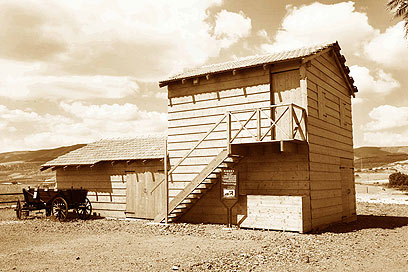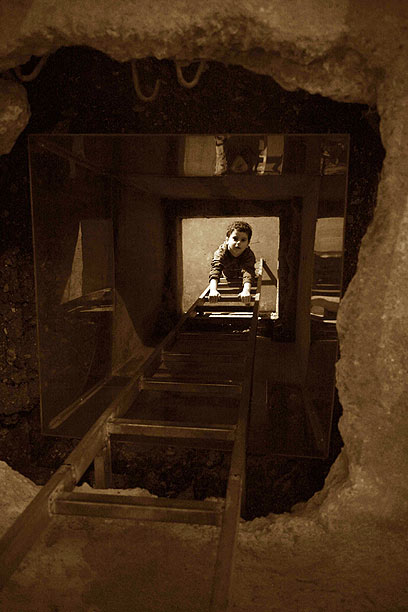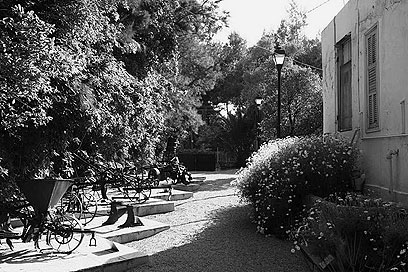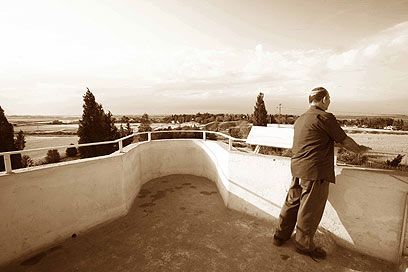

Visitors are invited to take part in a unique experience linking the sites' stories with the process of the State's establishment. The activities include tours, multimedia displays, pioneers shows, new exhibitions and activities for all ages.
Visitors will listen to exciting heritage and heroism stories about Joseph Trumpeldor in Tel-Hai, the illegal Jewish immigrants in Atlit and more.
The "63rd Independence – in the footsteps of Israel's Heritage Sites" photo collection was created following the initiative and with the support of Omri Shalmon, director of the Society for Preservation of Israel Heritage Sites.
Photographer Chen Leopold joined me on a six-day visit to heritage sites all across the country during the Passover holiday, and created an eclectic photo collection capturing the heritage sites and their ideological movement between daily life and the sublime.
During our journey, we encountered heritage sites sitting inside cities, next to residential buildings and some which you may simply pass by on your way somewhere else.
The process made us realize that the heritage sites are here for us not just on Independence Day, and that there are many in the Israeli society who visit heritage sites on a regular basis. For others, it's a concealed and unclear concept.
The photos in the different places tell stories. Here some of the sites and the photos accompanying them. Happy Independence Day!
1. Liberman House, Nahariya
In 1934, Nahariya's founders bought 593 acres from a Lebanese family for an agricultural Jewish settlement. Mr. Philip Liberman purchased 111 acres from the founders, which included a building and a farm.
Since then, the Liberman family played an important role in defending the Jewish settlement: Establishing a Notrim (Jewish police force) unit, training the founders of Evron, Shavei Zion and Neot Mordechai and helping guard the community.
An observation tower was added to the building, from which Yitzhak Rabin commanded the Palmach operations.
The Liberman House also absorbed and helped Jewish immigrants who arrived in Nahariya. Philip Liberman perished in the Holocaust. His son Binyamin, his wife and daughter lived in the building from 1945 and operated a sanatorium for orphans who survived the Holocaust, a high school and more. The place was renovated and opened as a museum.
Tel. 972-4-9821516; 972-52-5277589
Fax: 972-9822479
Email address: [email protected]

2. Hameiri House, Safed
Hameiri House Museum in the Old City of Safed illustrates in its location and story the endurance of the Jewish Quarter in 1948.
The impressive three-story building faces the neighborhood of Khart al-Romm'an on the western slope of the Arab Quarter, from which snipers moved between the graves of the ancient cemetery and fired at Jewish homes.
In this reality of an almost face-to-face war, the Hameiri House building served as the fighters' weapons training place in its rooms hidden within the mountain. On the upper floor, Safed's guards built defense posts and firing loopholes.
Today the museum tells the story of the old settlement and the remarkable cooperation between "Safed's elderly" and the Palmach fighters in the War of Independence until the city was liberated.
Tel. 972-4-6921939; 972-4-6971307
Email address: [email protected]
3. Tel-Hai
In the summer of 1907, an agricultural courtyard was built in the Upper Galilee. At the end of World War I it was turned into Kibbutz Tel-Hai.
The site includes a reconstructed building of the courtyard dating back more than 100 years. Modern multimedia systems have been installed in the walls and present the Tel-Hai story as a rare experience with relevant associations to the current Israeli reality.
Tel. 972-4-6951333
Email address: [email protected]

4. Kinneret Courtyard
The site includes a visitor center and a guided tour on the heritage of the Second Aliyah and the settlement in the Jordan Valley. The story of Kinneret Courtyard is the story of the Second Aliyah pioneers, who generated leaders, ideas and institutions which served as the foundation for the State of Israel.
The farm, which was active until 1949, had an important role in the history of the Land of Israel: The founders of the first kibbutz, Degania, and the first moshav, Nahalal, came from here. The Haganah, the organization which defended the Jewish settlement in the Land of Israel during the British Mandate era, was founded here in 1920.
A new exhibition is being showcased at the site, which was renovated and reconstructed in the past year by the Society for Preservation of Israel Heritage Sites.
Tel. 972-4-6709117
Email address: [email protected]

5. Umm Juni hut, Degania
Enter the world of the pioneers, from their first days in Europe, through the dilemma of immigrating to Israel, the establishment of the kibbutz and the attempt to realize Herzl's vision to create an exemplary society in the Land of Israel.
The hut, in which the first settlers lived in, was reconstructed by the Society for Preservation of Israel Heritage Sites in the past year and is open to visitors.
At the exhibition in the Degania courtyard, you'll get to meet figures from the far and near past, move between Europe of the early 20th century, the dining hall of the young kibbutz, take part in a bold night operation, play, sing and participate in the establishment of a new kibbutz.
Tel. 972-52-3749170
Email address: [email protected]

6. The 'Sliq' at Nahalal
A visit to the Sliq (hiding place for weapons) is a fascinating and unique experience which will take you to a different, secret and exciting period – the era of the British Mandate.
The Sliq was built under the disguise of a hole for the urine of cows in the nearby barn. It measures about 55 meters (180 feet) in size, about 5 meters (16 feet) underground.
It's one of the biggest weapons hiding places under the Haganah organization's command. The arms hidden there were handed over to the fighters in the War of Independence.
The site includes a unique museum which tells the story of the family intertwined into the history of the settlement and the State of Israel's security. Visitors can delve into the Sliq.
Tel. 972-52-3347194
Email address: [email protected]

The 'Sliq' at Nahalal
7. Ramat Yohanan Heritage Trail
The Ramat Yohanan battle took place in April 1948. It ended the war over the roads to Haifa and the Galilee during the War of Independence and led to a fundamental event in the relations of the Jews and Druze.
During the Independence Day tour, visitors will gather at the monument in memory of the battle's casualties, which is located at a fascinating observation post overlooking the Haifa Bay and Zvulun Valley.
We'll hear about the ways the residents of local kibbutzim and Kfar Ata coped with the threatening invasion of the Qawuqji army and the heroic story of the Carmeli Brigade fighters who drove them away.
The site also includes a short walking trail in an agricultural area of orchards and pasture, which will lead us to the well-guarded Haganah post in the kibbutz. We'll also visit an authentic Haganah weapons hiding place and view exhibitions and short films.
Tel. 972-4-8459240
Email address: [email protected]

8. Feinberg Estate in Hadera
One of the most beautiful and fascinating houses in Israel, which has undergone extensive preservation, opened to the public about three years ago. This is the house in which Avshalom Feinberg, the founder of Jewish spy network Nili, grew up in.
Visitors can listen to the family's fascinating stories, watch a film, meet with Rachel the loyal assistant, and sing Avshalom's "A Thousands Kisses" with Itzik the singer. A branch of the original Avshalom Palm can be seen in the yard.
While you're in Hadera, it is also recommended to visit the Khan Museum, which is also open to the public free of charge on Independence Day.
Tel. 972-4-6343296
Booking: 972-4-6322330
Email address: [email protected]

9. Beit Rishonim, Binyamina
An authentic building in the colony named after Baron Rothschild with a barnyard and a kitchen in which pictures, furniture, household utensils, musical instruments and tools from the first days of the colony (1922) are presented.
Beit Hanotrim is located next to Beit Rishonim in a building which served as the colony's first water tower and turned into a regional guarding center defending the colony and its surroundings.
The tower's rooftop served as an observation post and includes a display of weapons, a weapons hiding place, a broadcasting station and more.
The colony' residents were members and commanders of the Haganah, Irgun and Lechi, and served in the British army. Binyamina and its history are an example for the building and defense of the State.
Tel. 972-9-9548561;
Email address: [email protected]

Beit Rishonim
10. Independence Hall, Tel Aviv
The historic building in which David Ben-Gurion declared the establishment of the State of Israel. It was built by Meir Dizengoff, and also served as his personal residence and an art museum.
The historic hall was reconstructed very accurately. Visitors can review details and documents related to the declaration ceremony, listen to the original recording of the ceremony and watch a short film describing the events of that period and the house's history.
Tel. 972-3-5106426, 972-3-5173942
Email address: [email protected]
11. Kibbutz Sa'ad
A household opposite Gaza – a memorial site for the early settlement in the Negev of the three religious groups which were in the area during the War of Independence: Kfar Darom, Be'erot Yitzhak and Sa'ad.
The museum is located inside the security house – the only building which survived from before the War of Independence. The site describes the battle for security during the war, the use of water, and the development of Sa'ad since the War of Independence until now.
The site includes a beautiful observation of the Gaza vicinity and the area between Ashkelon and Netivot.
Tel. 972-52-8694507, 972-52-3726644
Email address: [email protected]

Kibbutz Sa'ad
12. Ben-Gurion's hut
In 1953, Prime Minister David Ben-Gurion resigned and moved into a hut built for him at Kibbutz Sde Boker in the Negev, in order to serve as a personal example for settling in the Negev. The hut has been preserved and remains as it was when Paula and David Ben-Gurion lived there.
An exhibition presented in the adjacent hut describes Ben-Gurion's special connection to the Negev and sheds light on the character of a leader who lived up to his principles.
The house describes Ben-Gurion's life, his affiliation to the Negev and his recognition of the settlement and economic potential of the southern region, as well as what has been done in the Negev in light of Ben-Gurion's vision.
There is no need to book a visit in advance.
Tel. 972-8-6560469
Email address: [email protected]

Ben-Gurion's hut
For the full list of the heritage sites and additional details, visit the websites of the Ministry of Culture and Sports and the Society for Preservation of Israel Heritage Sites .
Visits must be booked in advance. Contact details can be found on the Society for Preservation of Israel Heritage Sites website.
- Follow Ynetnews on Facebook















